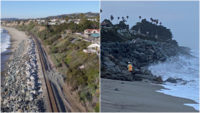The San Diego Association of Governments (SANDAG) this week marked the receipt of $300 million from the California Legislature to develop the realignment of track through the 1.7 miles of vulnerable Del Mar bluffs along the coastline.
For almost two decades, SANDAG has attempted to stabilize the oceanside bluffs that feature the Los Angeles-San Diego-San Luis Obispo (LOSSAN) rail, the key link for both passenger and freight from Mexico to Los Angeles. The funds are earmarked to complete the environmental process and advance engineering work for a long-term solution for construction of the realignment, even as the agency continues to seek funding for the project that officials say could range between $3 and $4 billion.
The LOSSAN corridor is truly a lifeline,” said California Senate President pro Tempore Toni G. Atkins at the announcement event on Oct. 13. “This project is the first step in improving its stability.”
The 351-mile LOSSAN rail corridor carries an estimated $1 billion in goods each year and the Del Mar section, which rises 50 to 70 ft above the ocean, has been closed off-and-on over the past two decades due to erosion of the bluffs. SANDAG has commissioned a study to refine alternative rail alignments for the roughly 2-mile Del Mar stretch.
Working with the North County Transit District, the California Dept. of Transportation and the United States Dept. of Transportation, the $3.2-million study was launched in summer 2020 and is scheduled for completion in early 2023. The plan is to evaluate five tunnel alignments originally identified in 2017 that would avoid the erosion-susceptible section by moving the tracks completely off the Del Mar bluff as well as allowing higher operating speeds.
The bluffs are eroding at a rate of four to six inches per year and require a long-term solution that necessitates moving the tracks underground, SANDAG states.
"Although potential alignment options are still being evaluated, the only way to ensure the long-term reliability of the rail line for years to come would include tunneling," the agency writes. "Replacing the current single-track alignment with an underground two-track alternative is the only feasible option to deliver the performance goals of the corridor and pave the way for high-speed rail."
The $300 million in new state funding will enable completion of the preliminary planning and design work for the new route. The new funding will allow SANDAG to begin environmental analysis of alignment alternatives, study potential impacts, address stakeholder concerns and identify future costs.
The new route would provide a permanent solution for a serious ongoing problem. Since 2003, there have been four stabilization projects along the coastal bluffs near Del Mar, costing $33.7 million. More than 230 support columns were added to the bluffs, along with drainage infrastructure designed to reinforce and protect them. Despite these efforts, in Feb. 2021 a bluff collapse required $10.5 million in emergency repairs of support columns as well as the rebuilding of the bluff slope from the bottom up, installation of sea walls and a new drainage system.
A $68-million fifth phase of stabilization construction is scheduled to begin in 2023. That work will include the addition of more support columns, replacement of aging drainage structures and protection of the base of the bluffs against additional bluff retreat, even as planning continues for a realignment fix.
The Del Mar bluffs are not the only section of the LOSSAN corridor susceptible to erosion issues. A portion of the tracks near the Orange and San Diego county line has been affected by the loss of adjacent beach.
Amtrak and Metrolink both ceased operations in late September when track shifting became a concern. California Transportation Commission issued an emergency declaration on Oct. 4. Officials with the Orange County Transportation Authority have undertaken repairs which are expected to have service restored in November.




Post a comment to this article
Report Abusive Comment